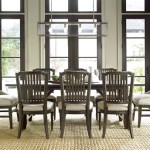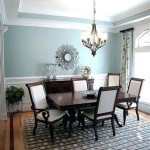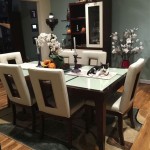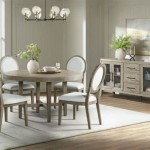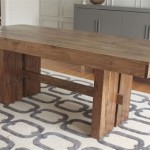Rustic Modern Dining Room Ideas: A Fusion of Styles
The rustic modern dining room represents a compelling design choice for homeowners seeking a balance between contemporary aesthetics and the warmth and character of traditional, nature-inspired elements. This style synthesizes clean lines and minimalist forms with the textures and raw beauty of natural materials, creating a space that is both inviting and sophisticated. Achieving this harmonious blend requires careful consideration of furniture selection, color palettes, lighting, and accent pieces. The goal is to cultivate a dining room that feels both current and timeless, a place where meals are enjoyed in an atmosphere of understated elegance and comforting familiarity.
This article will explore key aspects of designing a rustic modern dining room, providing insights and practical ideas to help homeowners effectively implement this design concept in their own spaces. The discussion will cover material choices, furniture styles, lighting strategies, and decorative elements, emphasizing how these components contribute to a cohesive and aesthetically pleasing environment.
Wood as a Cornerstone Element
Wood is arguably the most crucial element in creating a rustic modern dining room. Its inherent warmth and natural beauty serve as the foundation for the style. The wood utilized should ideally showcase natural grain patterns and textures. Consider using reclaimed wood flooring or incorporating a dining table crafted from solid wood slabs with live edges. These elements immediately introduce a sense of history and connection to nature. When selecting wood finishes, opting for matte or satin sheens will enhance the rustic appeal, avoiding overly polished or glossy surfaces that lean more towards contemporary styles. Different types of wood can be incorporated, such as oak, pine, or walnut, each offering unique variations in color and grain that can contribute to the overall aesthetic.
The integration of wood extends beyond the floor and dining table. Wood paneling, either on a single accent wall or as wainscoting, can add depth and visual interest to the room. Wooden beams, whether structural or decorative, further reinforce the rustic aesthetic, particularly in rooms with high ceilings. Even smaller details, such as wooden chairs or a wooden sideboard, contribute to the overall sense of warmth and naturalness. The key is to use wood strategically and purposefully, ensuring it is not overpowering but rather complements the other design elements within the room.
Furthermore, the treatment of the wood itself is important. Leaving knots, imperfections, and variations in color visible enhances the rustic feel. Refrain from excessively smoothing or sanding the wood, allowing its natural character to shine through. This contrast between the raw nature of the wood and the clean lines of modern design is what defines the rustic modern aesthetic.
Balancing Light and Texture
Lighting plays a pivotal role in setting the mood and highlighting the textures within a rustic modern dining room. The interplay between natural light and artificial light is essential to creating a balanced and inviting atmosphere. Maximize natural light by keeping windows unobstructed and considering sheer curtains that allow light to filter through while maintaining privacy. Consider the orientation of the room with respect to sunlight and plan accordingly. A south-facing room will naturally receive more light than a north-facing room.
Artificial lighting should complement the natural light, offering a range of options for different times of day and occasions. A statement pendant light fixture above the dining table serves as a focal point and provides ample illumination for meals. Consider options with metal accents, such as wrought iron or blackened steel, to enhance the rustic aesthetic. Dimmer switches allow for adjusting the light intensity to create a more intimate and relaxed atmosphere. Sconces mounted on the walls can provide ambient lighting and highlight architectural details or artwork. Table lamps or floor lamps can also be incorporated to add layers of light and create a more inviting ambiance.
Textures play a crucial role in the overall feel of the room. Think beyond wood and consider elements like exposed brick, natural stone, and textured fabrics. These materials add depth and visual interest, creating a tactile experience that enhances the rustic appeal. Consider adding a textured rug under the dining table to define the space and add warmth. Upholstered chairs with textured fabrics like linen or canvas can also contribute to the tactile feel of the room. The combination of natural light, artificial lighting, and varied textures creates a dining room that is visually stimulating and emotionally comforting.
Incorporating Modern Elements and Accents
While the rustic element is heavily influenced by natural materials and a weathered look, the "modern" aspect is equally important to maintain balance and sophistication. Modern design is characterized by clean lines, minimalist forms, and a focus on functionality. Integrating these elements into the dining room will create a space that is both stylish and practical.
Start with the furniture selection. Choose dining chairs with simple, geometric shapes and upholstered in neutral colors like gray, beige, or white. The dining table itself can have clean lines, even with a rustic wooden top. Consider a steel base for a contemporary touch, creating a contrast between the natural wood and the industrial metal. Keep the overall furniture arrangement uncluttered, allowing for ample space around the table and chairs. Avoid overly ornate or excessively decorated furniture pieces, as these will detract from the modern aesthetic.
Accents and decor play a crucial role in tying the rustic and modern elements together. Introduce pops of color through artwork, textiles, or decorative objects. Modern abstract art can provide a striking contrast against the rustic backdrop. Consider adding a metal sculpture or a ceramic vase to add visual interest. Keep the accessories minimal and purposeful, avoiding clutter. A few well-chosen pieces will have a greater impact than a collection of random objects.
Consider incorporating modern technology in a subtle and integrated way. A smart lighting system allows for convenient control of the lighting throughout the room. A sound system can be concealed within the walls or integrated into the furniture. The goal is to enhance the functionality of the room without sacrificing its aesthetic appeal. The key is to balance the rustic and modern elements, ensuring that neither one overshadows the other. This careful balancing act is what ultimately defines the rustic modern dining room style.
Achieving a successful rustic modern dining room requires a thoughtful approach to material selection, lighting design, and furniture arrangement. By focusing on natural materials, clean lines, and a balance of textures, homeowners can create a dining space that is both inviting and aesthetically pleasing. The key is to embrace the warmth and character of rustic elements while incorporating the functionality and sophistication of modern design principles.

75 Rustic Dining Room Ideas You Ll Love June 2025 Houzz
:max_bytes(150000):strip_icc()/de0a09_50941abc08ba4185be9559b9bc6c239emv2-97859b4f53504e0db0a5a4c80a0ad4e9.jpeg?strip=all)
32 Modern Farmhouse Dining Room Ideas Worth Copying

5 Rustic Glam Dining Rooms

5 Rustic Dining Room Ideas With Mismatched Furniture

Modern Rustic Dining Room Crate Barrel

15 Ways To Bring Rustic Warmth The Modern Dining Room Decoist

Modern Transitional Dining Room Decor Taryn Whiteaker Designs

20 Farmhouse Dining Room Decor Ideas S Rugs Direct

15 Rustic Dining Room Ideas Best Design Inspiration

Cozy Modern Cottage Dining Room Designs Edward George
See Also

